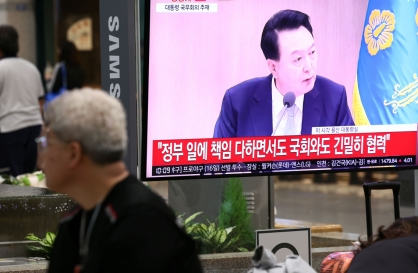[Editorial] Dialogue off the table
No talking NK into scrapping nukes; Blockade, deterrence the way to go
By Korea HeraldPublished : Sept. 5, 2017 - 17:34
Chairwoman of the ruling Democratic Party Choo Mi-ae on Monday proposed dispatching special envoys simultaneously to North Korea and the US to arrange for “two-track talks” between South and North Koreas and between the US and the North as a way to solve the North’s nukes problem.
Choo said in an address at the National Assembly, “The government must oppose war on the Korean Peninsula at any cost and should not stop nor give up efforts for dialogue.”
It is hardly understandable to make this remark just a day after the North’s sixth nuclear weapons test.
If the North fires a missile toward Seoul, it will land three or five minutes later, and if the missile is tipped with a nuclear warhead of the same strength as tested Sunday, most of the capital will be reduced to ashes.
Now is time to hasten to deploy weapons capable of deterring the nuclear threat from the North.
In this situation, her proposal from out of the blue to dispatch envoys to prepare for talks is preposterous.
Choo mentioned “dialogue” 12 times but “condemnation (of the sixth nuclear test)” just once in her speech. She has not let go of her wish for dialogue yet.
US President Donald Trump said that talking with the North is not the answer and that he was working on ultra-hard-line responses to the latest nuclear provocation.
If Choo knew what the current state of South-North relations was like, she would not have come up with the idea of sending a special envoy to Pyongyang. An inter-Korean telephone line has long been disconnected, and the North has not even cast a look at offers from the South.
According to Defense Minister Song Young-moo on Monday, the National Security Council made a decision toward strengthening military confrontation rather than seeking dialogue in its meeting convened shortly after the latest nuclear test.
Given that a nuclear crisis is just around the corner, such decision is a belated yet right direction.
Still, the presidential office keeps the frame of its North Korea policy unchanged.
A senior Cheong Wa Dae official said after the sixth nukes test, “There is still distance left to the red line.”
Its policy keynote is that strong sanctions and pressure should be applied for the short term, while dialogue and negotiations should be pursued for the long term.
Talking Pyongyang into scrapping its nuclear weapons could not be better.
But it is no more than a wishful thinking.
Undoubtedly, the North crossed the Rubicon when it enhanced its nuclear arms.
The South has already passed the stage at which dialogue can be tried with hope. Efforts to isolate the North and deter its nuclear threats are in desperate need. The North will likely mount another provocation sooner or later.
The new government has pursued dialogue and sanctions simultaneously, but dialogue attempts have gone nowhere and signs of its success in the future are nowhere to be seen.
Experts predict the North will not respond to dialogue offers until it perfects nuclear-tipped intercontinental ballistic missiles.
It is expected to take one or two years at the most for North Korea to field nuclear ICBMs for actual warfare.
The Moon government must take a path it has shunned, which is to put pressure strong enough to wake up the North, as Moon mentioned in his phone talks with Japanese Prime Minister Shinzo Abe. Blockades and deterrence are the way to go.
Regime change is one of the surest ways, but an overthrow from within is a long shot. Still, simulated bombing training targeting the hideouts of the North leadership is needed to put pressure on its leader Kim Jong-un.
Unless the North’s nukes are deterred, any dialogue that happens will not be the dialogue that appeasement advocates wish for. At the dialogue table, the South may hear the North say, “choose between our demands or war.”
The dialogue option became untenable when the North Korean nuclear problem crossed the point of no return.
-
Articles by Korea Herald






![[From the Scene] Monks, Buddhists hail return of remains of Buddhas](http://res.heraldm.com/phpwas/restmb_idxmake.php?idx=644&simg=/content/image/2024/04/19/20240419050617_0.jpg&u=20240419175937)








![[From the Scene] Monks, Buddhists hail return of remains of Buddhas](http://res.heraldm.com/phpwas/restmb_idxmake.php?idx=652&simg=/content/image/2024/04/19/20240419050617_0.jpg&u=20240419175937)

![[KH Explains] Hyundai's full hybrid edge to pay off amid slow transition to pure EVs](http://res.heraldm.com/phpwas/restmb_idxmake.php?idx=652&simg=/content/image/2024/04/18/20240418050645_0.jpg&u=20240419100350)

![[Today’s K-pop] Illit drops debut single remix](http://res.heraldm.com/phpwas/restmb_idxmake.php?idx=642&simg=/content/image/2024/04/19/20240419050612_0.jpg&u=)